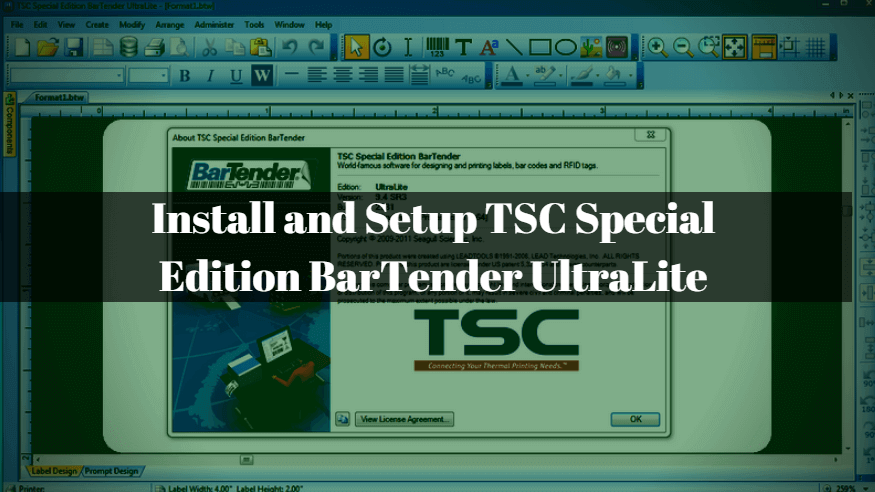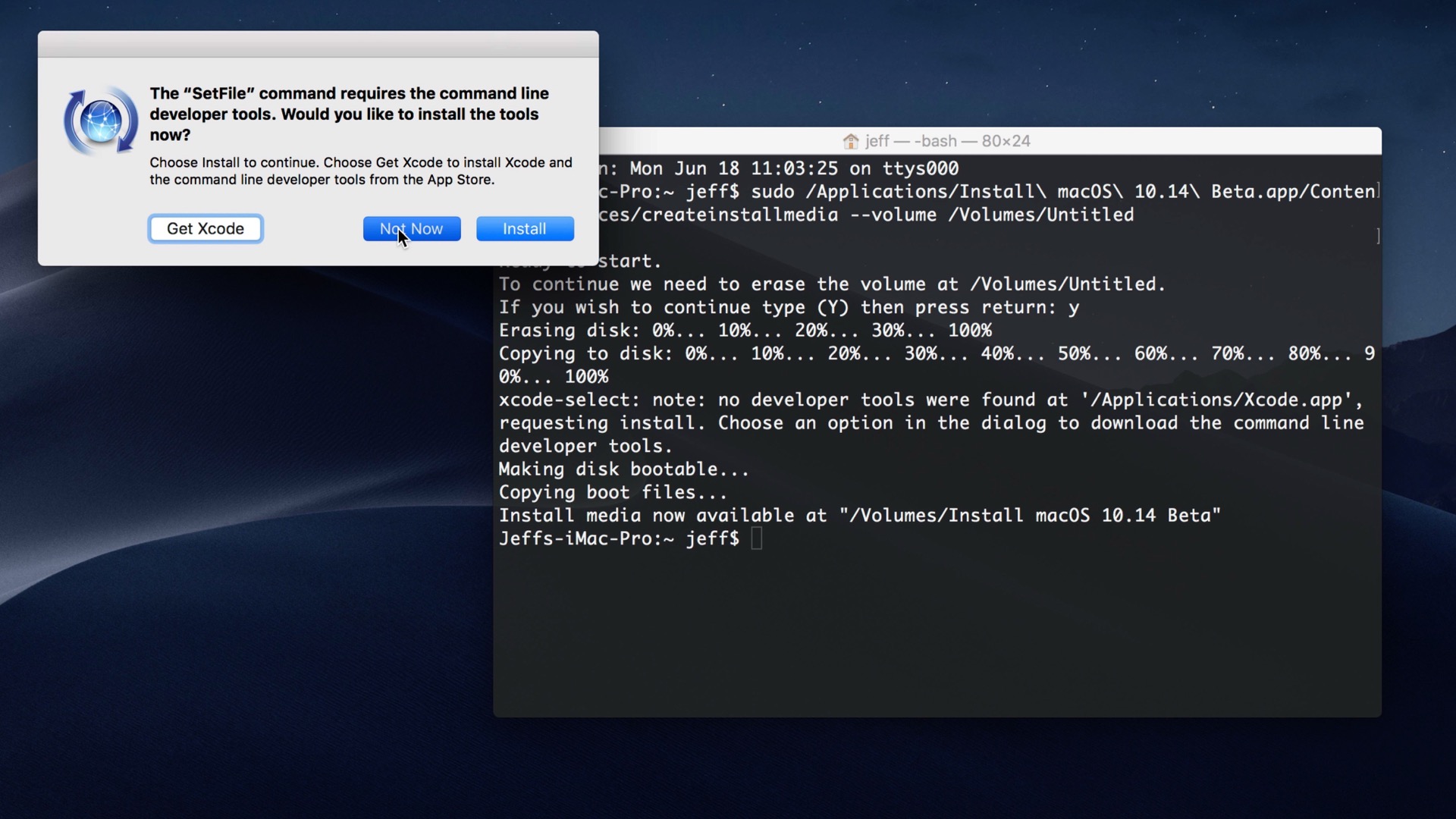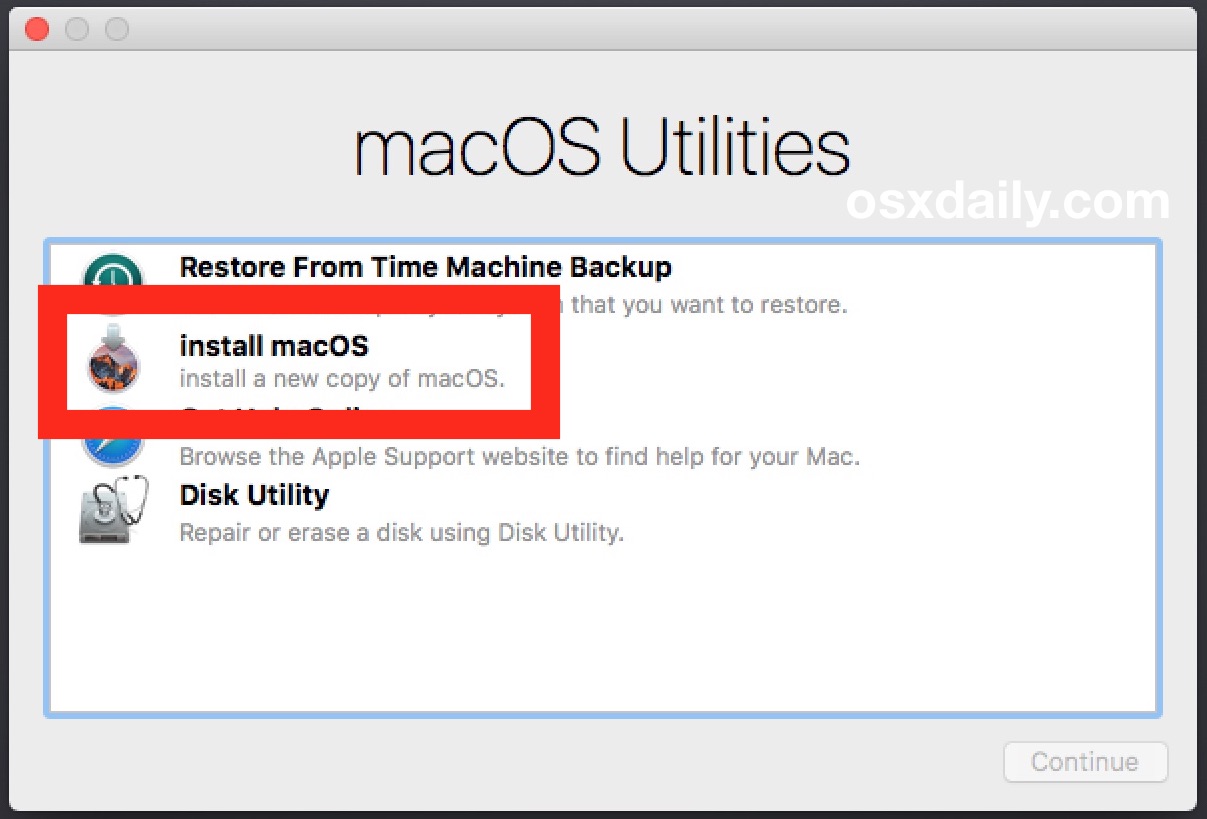- To Setup The Installation Of Macos Mojave Click Continue Date
- How To Do A Fresh Install Of Macos Mojave
- To Setup The Installation Of Macos Mojave Click Continue Download
- How To Do A Fresh Install Of Macos Catalina
- To Setup The Installation Of Macos Mojave Click Continue Free
Big Sur, Catalina, or Mojave is recommended for this version. To install, download the razorsql933.dmg (Big Sur, Catalina, Mojave or High Sierra only) or razorsql933x64.dmg (for Lion, Mountain Lion, Mavericks, Yosemite, El Capitan, macOS Sierra, macOS High Sierra, macOS Mojave) file to your machine. Double click the.dmg file. Running macOS Mojave Vmware. Open the Vmware app and double click on the macOS Mojave VM or select it and click the Power on button. Select your preferred language and complete the user setup by creating a user account. After the user setup is done and you log on to the OS, the resolution might be very low.
Besides windows, macOS is the 2nd most used operating system in the world. The combination of unique features, design and ultimate stability makes it very great. Even on a Hackintosh, it provides great stability if configured correctly. In this article, you will know how easy it is to install macOS Mojave on VMware. If you want to run heavy workload such as video editing tools then you running macOS on a virtual machine might not be perfect for you as it will run slow, instead try our dual booting macOS mojave with windows guide.
Let's start the process!
Downloading the required files.
1. At first, we need to download and install the latest version of VMware workstation player or workstation. VMware is best for installing and running virtual machines whether it be Linux, Windows or macOS, though it doesn't support macOS out of the box but with some tweaks, it runs flawlessly. In this tutorial, I am going to use VMware workstation player because it is free for personal use, but VMware workstation will work perfectly too.
2. Now download the patch tool for patching VMware.
3. At last download the macOS Mojave virtual machine image.
Patching VMware.
As i said above VMware doesn't support running macOS out of the box. The Unlocker aka patch tool patches VMware with required files and makes it support running macOS.
1. Before patching, make sure that you have installed VMware after downloading.
2. Extract the 'patch tool.rar' file using Winrar.
3. Open the extracted folder and right click on win-install and click 'run as administrator'.
Note: Before running the patch tool make sure that you have active internet connection as the patch tool will download VMware tools, which is required to be installed on the macOS for proper graphics and CPU acceleration.
4. Wait till the patching process is finished.
See also: Beginner's guide to patch DSDT in Hackintosh
Creating the macOS virtual machine.
As the patching process is finished we can now proceed to create the virtual machine for macOS Mojave.
1. Open the VMware Workstation player and click on 'Create a new virtual machine'
2. Next, select 'I want to install the operating system later' and click next. As we have downloaded the virtual disk image which contains macOS Mojave already installed, we will tie it later.
3. Now under Operation system selection, select 'Apple Mac OS X' and then from the version drop-down menu select 'macOS 10.14' which is macOS Mojave, and then click Next.
4. Here, name the virtual machine as you like and select the location where you want the virtual machine to be installed and click next.
As the size of the vmdk (virtual machine disk) file is going to be increased as you install apps or download stuff inside your macOS virtual machine. So it is better to install it where you have plenty of space available or at 50gb, So later you won't need to move it.

5.Leave the maximum disk size to default which is 40 Gb, and select 'Store virtual disk as a single file' and then click next.
The maximum disk size doesn't matter much because we will change it to our pre-installed macOS Mojave VMware disk.
Configuring the macOS Mojave VM.
Till now we have successfully created our macOS Mojave virtual machine but that's only 20% of the work. We now need to configure it correctly by setting how much hardware it is allowed to use, so your both the host OS (windows in my case) and macOS Mojave runs without hiccups.
1. Select the VM and then click on the edit button, we will now change the configuration of the virtual machine to allocate it more processor cores and ram to make the virtual machine perform well.
See also: How to create bootable macOS high sierra USB on windows.
Here click on the memory tab and slide up the slider to 60% of your ram. Next, click on the processor's tab and change the number of cores to 4 or higher if your processor has a higher core count. Virtual machines are emulated with virtual processors means that the higher the core count the higher the performance will be.
2. Now select the 'hard disk' tab and click the remove button, it is required to be removed as we will add the pre-installed disk.
3. After removing the existing hard disk, click on the add button and select the hard disk option from the menu and click next.
4. In the Add hard disk wizard window, select the Disk type option as SATA and click next.
5. Under disk selection tab select the 'Use an existing disk' and click next, now copy paste the path of the downloaded vmdk file or click browse and select the downloaded macOS Mojave vmdk file.
Editing and running the Virtual machine.
In the above steps we have successfully configured our macOS Mojave virtual machine, but we need to edit the VMware configuration file so that the virtual machine runs correctly.
1. Open the folder that you selected while configuring the virtual machine in step 4 of 'Creating the macOS virtual machine'.

2. Now look for a file with the extension '.vmx' the name of the file will be the name of the virtual machine.
3. Right click on the configuration file, then select open with and then notepad or any other text editor.

4. At the bottom of the file add this line:
and save the file.
See also: How to undervolt a mac to increase its battery life.
Running macOS Mojave Vmware.
1. Open the Vmware app and double click on the macOS Mojave VM or select it and click the Power on button.
To Setup The Installation Of Macos Mojave Click Continue Date
2. Select your preferred language and complete the user setup by creating a user account.

3. After the user setup is done and you log on to the OS, the resolution might be very low. To fix this we need to install the VMware tools.
4. To install VMware tools, double-click on the mounted disk on the top right, and then open the 'Install VMware tools'.
5. On the installer, click continue and keep the destination at default and then click install, after successfully installing the tools restart the VM and all should be good now.
If you find any issues or problem in the process please post them in comments.
Moving to a new Mac? Before taking these steps, you can use Migration Assistant to move your files from the old Mac to your new Mac.
Create a backup
Make sure that you have a current backup of your important files. Learn how to back up your Mac.
How To Do A Fresh Install Of Macos Mojave
Sign out of iTunes in macOS Mojave or earlier
If you're using macOS Mojave or earlier, open iTunes. From the menu bar at the top of the screen or iTunes window, choose Account > Authorizations > Deauthorize This Computer. Then enter your Apple ID and password and click Deauthorize.
Learn more about deauthorizing computers used with your iTunes account.
Sign out of iCloud
If you're using macOS Catalina or later, choose Apple menu > System Preferences, then click Apple ID. Select Overview in the sidebar, then click Sign Out.
If you're using macOS Mojave or earlier, choose Apple menu > System Preferences, click iCloud, then click Sign Out.
You will be asked whether to keep a copy of your iCloud data on this Mac. You can click Keep a Copy, because you're erasing your Mac later. Your iCloud data remains in iCloud and on any other devices that are signed in to iCloud with your Apple ID.
Sign out of iMessage
If you're using OS X Mountain Lion or later, open the Messages app, then choose Messages > Preferences from the menu bar. Click iMessage, then click Sign Out.
Reset NVRAM

5.Leave the maximum disk size to default which is 40 Gb, and select 'Store virtual disk as a single file' and then click next.
The maximum disk size doesn't matter much because we will change it to our pre-installed macOS Mojave VMware disk.
Configuring the macOS Mojave VM.
Till now we have successfully created our macOS Mojave virtual machine but that's only 20% of the work. We now need to configure it correctly by setting how much hardware it is allowed to use, so your both the host OS (windows in my case) and macOS Mojave runs without hiccups.
1. Select the VM and then click on the edit button, we will now change the configuration of the virtual machine to allocate it more processor cores and ram to make the virtual machine perform well.
See also: How to create bootable macOS high sierra USB on windows.
Here click on the memory tab and slide up the slider to 60% of your ram. Next, click on the processor's tab and change the number of cores to 4 or higher if your processor has a higher core count. Virtual machines are emulated with virtual processors means that the higher the core count the higher the performance will be.
2. Now select the 'hard disk' tab and click the remove button, it is required to be removed as we will add the pre-installed disk.
3. After removing the existing hard disk, click on the add button and select the hard disk option from the menu and click next.
4. In the Add hard disk wizard window, select the Disk type option as SATA and click next.
5. Under disk selection tab select the 'Use an existing disk' and click next, now copy paste the path of the downloaded vmdk file or click browse and select the downloaded macOS Mojave vmdk file.
Editing and running the Virtual machine.
In the above steps we have successfully configured our macOS Mojave virtual machine, but we need to edit the VMware configuration file so that the virtual machine runs correctly.
1. Open the folder that you selected while configuring the virtual machine in step 4 of 'Creating the macOS virtual machine'.
2. Now look for a file with the extension '.vmx' the name of the file will be the name of the virtual machine.
3. Right click on the configuration file, then select open with and then notepad or any other text editor.
4. At the bottom of the file add this line:
and save the file.
See also: How to undervolt a mac to increase its battery life.
Running macOS Mojave Vmware.
1. Open the Vmware app and double click on the macOS Mojave VM or select it and click the Power on button.
To Setup The Installation Of Macos Mojave Click Continue Date
2. Select your preferred language and complete the user setup by creating a user account.
3. After the user setup is done and you log on to the OS, the resolution might be very low. To fix this we need to install the VMware tools.
4. To install VMware tools, double-click on the mounted disk on the top right, and then open the 'Install VMware tools'.
5. On the installer, click continue and keep the destination at default and then click install, after successfully installing the tools restart the VM and all should be good now.
If you find any issues or problem in the process please post them in comments.
Moving to a new Mac? Before taking these steps, you can use Migration Assistant to move your files from the old Mac to your new Mac.
Create a backup
Make sure that you have a current backup of your important files. Learn how to back up your Mac.
How To Do A Fresh Install Of Macos Mojave
Sign out of iTunes in macOS Mojave or earlier
If you're using macOS Mojave or earlier, open iTunes. From the menu bar at the top of the screen or iTunes window, choose Account > Authorizations > Deauthorize This Computer. Then enter your Apple ID and password and click Deauthorize.
Learn more about deauthorizing computers used with your iTunes account.
Sign out of iCloud
If you're using macOS Catalina or later, choose Apple menu > System Preferences, then click Apple ID. Select Overview in the sidebar, then click Sign Out.
If you're using macOS Mojave or earlier, choose Apple menu > System Preferences, click iCloud, then click Sign Out.
You will be asked whether to keep a copy of your iCloud data on this Mac. You can click Keep a Copy, because you're erasing your Mac later. Your iCloud data remains in iCloud and on any other devices that are signed in to iCloud with your Apple ID.
Sign out of iMessage
If you're using OS X Mountain Lion or later, open the Messages app, then choose Messages > Preferences from the menu bar. Click iMessage, then click Sign Out.
Reset NVRAM
Shut down your Mac, then turn it on and immediately press and hold these four keys together: Option, Command, P, and R. Release the keys after about 20 seconds. This clears user settings from memory and restores certain security features that might have been altered.
Learn more about resetting NVRAM or PRAM.
Optional: Unpair Bluetooth devices that you're keeping
If your Mac is paired with a Bluetooth keyboard, mouse, trackpad, or other Bluetooth device that you plan to keep, you can unpair it. This optional step prevents accidental input when the Mac and device have separate owners but remain in Bluetooth range of each other.
If you're unpairing Bluetooth input devices from a desktop computer such as an iMac, Mac mini, or Mac Pro, you must plug in a USB keyboard and mouse to complete the remaining steps in this article.
To unpair a Bluetooth device, choose Apple menu > System Preferences, then click Bluetooth. Move your pointer over the device that you want to unpair, then click the remove (x) button next to the device name.
To Setup The Installation Of Macos Mojave Click Continue Download
Erase your hard drive and reinstall macOS
The best way to restore your Mac to factory settings is to erase your hard drive and reinstall macOS.
How To Do A Fresh Install Of Macos Catalina
After macOS installation is complete, the Mac restarts to a setup assistant that asks you to choose a country or region. To leave the Mac in an out-of-box state, don't continue setup. Instead, press Command-Q to shut down the Mac. When the new owner turns on the Mac, the setup assistant guides them through the setup process.
To Setup The Installation Of Macos Mojave Click Continue Free
No matter the model or condition, we can turn your device into something good for you and good for the planet: Learn how to trade in or recycle your Mac with Apple Trade In.

